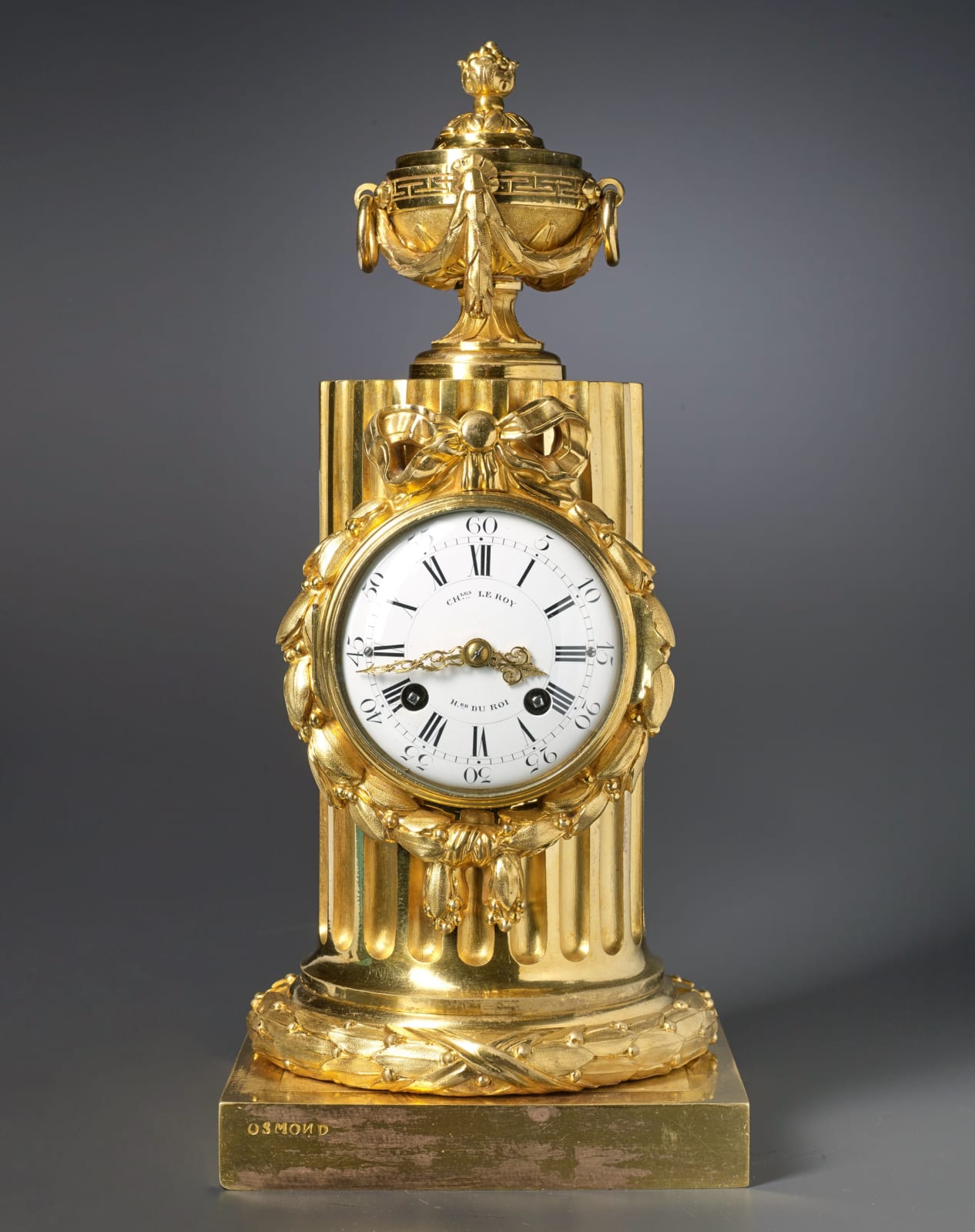Charles Le Roy
Literature
Hans Ottomeyer and Peter Pröschel, "Vergoldete Bronzen", 1986, p. 194, pl. 3.12.3, illustrating an identical clock case composed of a gilt bronze column, the case by Robert and Jean-Baptiste Osmond and movement by Gudin à Paris, in Stockholm Castle. Pierre Kjellberg, "Encyclopédie de la Pendule Française du Moyen Age au XXe Siècle", 1997, p. 185, colour illustration showing a case of identical design with gilt bronze column stamped Osmond with movement by Louis Montjoye. Kjellberg also cites another almost identical case with movement by Jean-Baptiste Dutertre l'Aîné. Elke Niehüser, "Die Französische Bronzeuhr", 1997, p. 252, pl. 1091, illustrating another identical clock case.
An important Louis XVI gilt bronze column clock of eight day duration by the firm of royal clockmakers Charles Le Roy, housed in a magnificent gilt bronze case by the eminent bronziers Robert Osmond and Jean-Baptiste Osmond, signed on the white enamel dial Chles Le Roy / H.er Du Roi and stamped on the case Osmond. The dial with Roman and Arabic numerals and a very fine pair of pierced gilt brass hands for the hours and minutes. The spring driven movement with anchor escapement, silk thread suspension, striking on the hour and half hour on a single bell, with outside count wheel. The circular gilt bronze bezel surrounded by a ribbon-tied laurel wreath mounted upon a fluted column, surmounted by a gilt bronze covered vase with a berried finial above a band ornamented with Greek key motifs, ring handles and laurel swags, the base of the column with a berried laurel wreath band resting on a square base
Paris, date circa 1770
Height 35.5 cm, the base: 16 x 16 cm.
The importance of this clock not upon relies upon its quality but also the esteem of its clock and case makers. The case was made by Robert Osmond (1711-89, maître 1746) and his nephew Jean-Baptiste Osmond (1742- after 1790, maître 1764), who ran one of the leading firms of eighteenth century bronziers and made a number of column clock cases with varying differences in decoration. The design for this particular model appears in the Osmond's "Livre de desseins", no. 53, priced at 198 livres.
Robert Osmond was one of the most prolific as well as one of the most successful fondeur-ciseleurs of his day, working as adeptly in the Louis XV as the Louis XVI style. Valued by connoisseurs today, as much as in his day, his bronzes were widely distributed by clockmakers and marchands-merciers. He was born in Canisy, near Saint-Lô and having entered his apprenticeship at a late stage became a maître in 1746 and from 1764 until 1775 worked in association with his nephew Jean-Baptiste Osmond. In addition to column clocks Osmond specialised in cartel cases as well as others shaped as vases with lions' heads. Another remarkable one being a clock decorated with a globe, cupids and a Sèvres porcelain plaque (Musée du Louvre, Paris). Osmond's work can be found among the world's finest collections including the Musée des Arts Décoratifs and Musée Nissim-de-Camondo in Paris, the Musée Condé at Chantilly, the Nationalmuseet Stockholm and the Museum of Art Cleveland, Ohio.
One of the charms of this clock is its compact size in addition to the fact that the movement was made by the eminent Parisian firm of Charles Le Roy. Referred to in glowing terms in the principal almanacs of the second half of the eighteenth century, this clockmaking concern was run firstly by Charles Le Roy (1709-71) who became a maître in 1733, then in conjunction with his equally brilliant son Etienne-Augustin (b. Paris 1737 d. after 1792) and finally by Etienne-Augustin alone. Charles Le Roy was firstly established at rue des Prêcheurs and then sometime before 1745 moved to rue Saint-Denis. Etienne-Augustin was received as a maître-horloger in 1758 and was subsequently appointed Horloger du Roi to King Louis XVI. After his father's death, he remained at rue Saint-Denis and continued to sign his dials 'Charles Le Roy'. In 1792/95 he sold the concern to Gaspard Cachard, who in acknowledgement styled himself as 'Cachard, Succr, de Ch. Le Roy'.
In its earliest days, the Le Roy workshop specialised in manufacture of watches but after about 1760 clock production dramatically increased. The firm's clock cases were made by the leading makers of the day, which in addition to the Osmonds, those made in bronze included the Caffiéris, Jean-Joseph de Saint-Germain, François Vion, François Rémond, Cottin, Etienne Martincourt, Zaccon, Frémont, Le Mire and E. Blavet, while veneered cases were made by such ébénistes as Balthazar Lieutaud, Antoine Foullet, Pécourt, François Duhamel and François Goyer. Elie Barbezat, who also supplied Imbert l'Aîné, Julien Le Roy and Robert Robin, made a number of the firm's dials. An inventory of Louis XVI's clocks made in 1788 recorded nine by Charles Le Roy, all in the king's private apartments at Versailles. A list of clocks belonging to the Menus Plaisirs, 1793, mentioned a tenth clock (which is now accepted as the one in the J. Paul Getty Museum, California).
In addition to Louis XVI, the firm's clientele included the comte de Provence, Mademoiselle de Clermont and the courts of Sweden and Saxony. Today one can find works by Charles Le Roy in such notable collections as the Mathematisch-Physikalischer Salon, Dresden, the Nordiske Museum, Stockholm and in the Feill and Ilbert collections. Further examples are housed in the Musées du Louvre, Cognac-Jay and Jacquemart-André in Paris, the Historisches Museum Basel, the Walters Art Gallery Baltimore, the J. P. Getty Museum, California and the Metropolitan Museum, New York.
